
Silphidae is a family of beetles that are known commonly as large carrion beetles, carrion beetles or burying beetles. There are two subfamilies: Silphinae and Nicrophorinae. Nicrophorines are sometimes known as sexton beetles. The number of species is relatively small at around two hundred. They are more diverse in the temperate region although a few tropical endemics are known. Both subfamilies feed on decaying organic matter such as dead animals. The subfamilies differ in which uses parental care and which types of carcasses they prefer. Silphidae are considered to be of importance to forensic entomologists because when they are found on a decaying body they are used to help estimate a post-mortem interval.

Staphylinoidea is a superfamily of beetles. It is a very large and diverse group with worldwide distribution.

Quickella is a monotypic genus of land snail in the family Succineidae, the amber snails. It is known commonly as the sandbowl snail. The only species is Quickella arenaria.

Agyrtidae, or primitive carrion beetles, are a small family of beetles belonging to Staphylinoidea. They are found in mostly temperate areas of the Northern Hemisphere and in New Zealand.
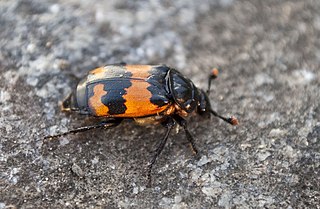
Nicrophorus investigator is a burying beetle first described by the Swedish naturalist Johan Wilhelm Zetterstedt in 1824.

Nicrophorus vespilloides is a burying beetle described by Johann Friedrich Wilhelm Herbst in 1783.
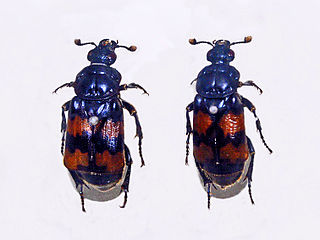
Nicrophorus vestigator is a species of beetle belonging to the family Silphidae.
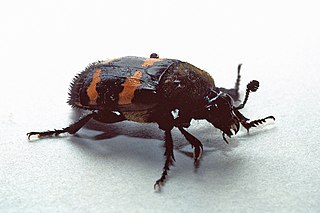
Nicrophorus tomentosus is a species of burying beetle that was described by Friedrich Weber in 1801. The beetle belongs to the family Silphidae which are carrion beetles. The beetles have sensitive antennae that contain olfactory organs. Thus, the beetle can locate dead animals (carcass), and then as the name suggests, can bury them. However, unlike other burying beetles, N. tomentosus does not completely bury these brood carcasses. They instead dig a shallow hole under the carcass and cover it with leaf litter. Recognition of these beetles can be distinguished by its black color with orange markings on the wing covers (elytra).
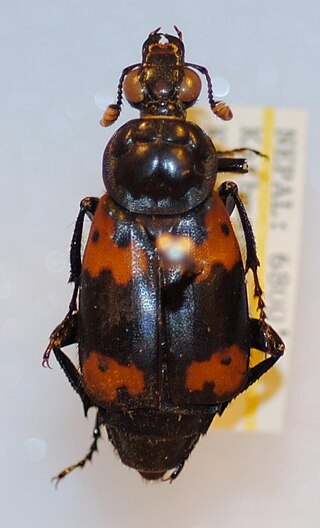
Nicrophorus nepalensisHope,, commonly known as burying beetle, is widespread across tropical and subtropical countries in Asia. It belongs to the order Coleoptera and the family Silphidae, and is part of the nepalensis species-group, which is the second largest species group within the genus Nicrophorus. N. nepalensis differs from some other beetles in that it exhibits biparental care. Its role as a decomposer is crucial in the energy cycle and energy transformation in the ecosystem.

Nicrophorus orbicollis is a nearctic burying beetle first described by Thomas Say in 1825. It is a member of the genus Nicrophorus or sexton beetles, comprising the most common beetles in the family Silphidae. This species is a decomposer feeding on carcasses of small dead animals. N. orbicollis can be used for scientific research both medically and forensically.

Poecilochirus is a Holarctic genus of mites in the family Parasitidae. They are relatively large and often found on rotting corpses, where they are transported by beetles. Deuteronymphs are characterized by two orange dorsal shields and in many species a transverse band on the sternal shield. The juvenile development consists of a larval stage, protonymph, and deuteronymph, but no tritonymph. Females are smaller than males. Males guard female deuteronymphs shortly before these mate, and pairs mate venter-to-venter.

Oiceoptoma noveboracense is a member of the family Silphidae, or carrion beetles, which feed on decaying organic matter such as dead animals. Its common name is the margined carrion beetle, from the orange-red margins on the pronotum, which are helpful when identifying this species. The larva is typically light brown to red and also has vertical ridges on its thorax like the adult. This diurnal beetle can be found mainly in the spring into the fall, and it has a strong preference towards a deciduous forest habitat. The primary forensic importance of this beetle is its ability to use the succession of insect fauna to provide confirmation of postmortem intervals.
C. arenaria may refer to:

Silphinae is a subfamily of burying beetles or carrion beetles. There are 113 extant species of this subfamily, in two tribe and in 14 genera. It contains the following tribes and genera:

Ablattaria laevigata is a species of burying beetle or carrion beetle belonging to the family Silphidae.

Ablattaria is a genus of burying beetles or carrion beetles belonging to the family Silphidae. The beetles are predators of gastropods. All species in the genus exhibit sexual dimorphism.
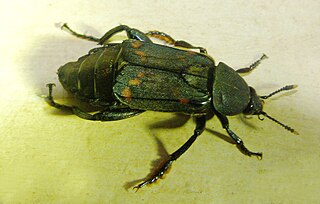
Diamesus osculans, is a species of carrion beetle found in Sri Lanka, Indonesia, Philippines, Laos, China, Australia.

Necrophila (Deutosilpha) rufithorax, is a species of carrion beetle found in India, Nepal and Sri Lanka. The species also known to live in Laos and Thailand, but might be another species.

Oiceoptoma thoracicum, the red-breasted carrion beetle, is a species of carrion beetle in the family Silphidae. It is found in the Palearctic. As a carrion beetle, this species is a generalist that can have importance in forensic entomology. Larval survival to adulthood occurs most often if the beetles are fed pork compared to beef or chicken.


















